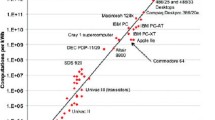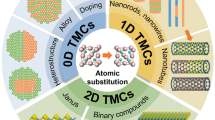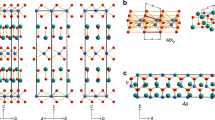Abstract
Non-layered transition metal carbides (TMCs) and layered transition metal dichalcogenides (TMDs) are two well-studied material families that have individually received considerable attention over the past century. In recent years, with the shift towards two-dimensional materials and heterostructures, a field has emerged that is focused on the structure and properties of TMC/TMD heterostructures, which through chemical conversion exhibit diverse types of heterostructure configuration that host coupled 2D–3D interfaces, giving rise to exotic properties. In this Review, we highlight experimental and computational efforts to understand the routes to fabricate TMC/TMD heterostructures. Furthermore, we showcase how controlling these heterostructures can lead to emergent electronic transport, optical properties and improved catalytic properties.




Similar content being viewed by others
References
Jariwala, D., Marks, T. J. & Hersam, M. C. Mixed-dimensional van der Waals heterostructures. Nat. Mater. 16, 170–181 (2017).
Bae, S. H. et al. Integration of bulk materials with two-dimensional materials for physical coupling and applications. Nat. Mater. 18, 550–560 (2019).
Naguib, M. et al. Two-dimensional nanocrystals produced by exfoliation of Ti3AlC2. Adv. Mater. 23, 4248–4253 (2011).
Shan, G., Ding, Z. & Gogotsi, Y. Two-dimensional MXenes and their applications. Front. Phys. 18, 13604 (2023).
Hwu, H. H. & Chen, J. G. Surface chemistry of transition metal carbides. Chem. Rev. 105, 185–212 (2005).
Xu, C. et al. Large-area high-quality 2D ultrathin Mo2C superconducting crystals. Nat. Mater. 14, 1135–1141 (2015).
Wang, C. et al. Transport properties of topological semimetal tungsten carbide in the 2D limit. Adv. Electron. Mater. 5, 1800839 (2019).
Zhang, C. et al. Growth of self-aligned single-crystal vanadium carbide nanosheets with a controllable thickness on a unique staked metal substrate. Appl. Surf. Sci. 499, 143998 (2020).
Hao, M. et al. Transport through a network of two-dimensional NbC superconducting crystals connected via weak links. Phys. Rev. B 101, 115422 (2020).
Wang, Z. et al. Metal immiscibility route to synthesis of ultrathin carbides, borides, and nitrides. Adv. Mater. 29, 1700364 (2017).
Suryaprakash Rao, P. & Prasad, P. M. Direct synthesis of Mo2C by molybdenite-CO reaction in the presence of lime. Mater. Trans. 34, 1229–1233 (1993).
Suryaprakash Rao, P., Mankhand, T. R. & Prasad, P. M. Kinetics of formation of molybdenum carbide (Mo2C) by reaction between carbon monoxide and molybdenite or molybdenum. Mater. Trans. JIM 37, 239–244 (1996).
Hara, Y., Minami, N. & Itagaki, H. Synthesis and characterization of high-surface area tungsten carbides and application to electrocatalytic hydrogen oxidation. Appl. Catal. A 323, 86–93 (2007).
Chang, H.-Q., Zhang, G.-H. & Chou, K.-C. Topochemical synthesis of two-dimensional molybdenum carbide (Mo2C) via Na2CO3-assisted carbothermal reduction of 2H-MoS2. Mater. Chem. Phys. 244, 122713 (2020).
Rothschild, A. et al. Encapsulation of WC within 2H-WS2 inorganic fullerene-like cages. Chem. Commun. 2, 363–364 (1999).
Xiao, Y. et al. Building MoSe2-Mo2C incorporated hollow fluorinated carbon fibers for Li-S batteries. Composites B 193, 108004 (2020).
Tang, C. et al. Sulfur-decorated molybdenum carbide catalysts for enhanced hydrogen evolution. ACS Catal. 5, 6956–6963 (2015).
Zhang, K. et al. MoS2 nanosheet/Mo2C-embedded N-doped carbon nanotubes: synthesis and electrocatalytic hydrogen evolution performance. J. Mater. Chem. A 2, 18715–18719 (2014).
Shao, M. et al. Carbonized MoS2: super-active co-catalyst for highly efficient water splitting on CdS. ACS Sustain Chem. Eng. 7, 4220–4229 (2019).
Nguyen, T. P. et al. Strategy for controlling the morphology and work function of W2C/WS2 nanoflowers. J. Alloy. Compd 829, 154582 (2020).
Nguyen, T. P. et al. Facile synthesis of W2C@WS2 alloy nanoflowers and their hydrogen generation performance. Appl. Surf. Sci. 504, 144389 (2020).
Nguyen, T. P. & Kim, I. T. W2C/WS2 alloy nanoflowers as anode materials for lithium-ion storage. Nanomaterials 10, 1336 (2020).
Zhang, F. et al. Superconductivity enhancement in phase-engineered molybdenum carbide/disulfide vertical heterostructures. Proc. Natl Acad. Sci. USA 117, 19685–19693 (2020).
Wu, J. et al. Growth of molybdenum carbide–graphene hybrids from molybdenum disulfide atomic layer template. Adv. Mater. Interf. 4, 4–9 (2017).
Hussain, S. et al. MoS2@X2C (X = Mo or W) hybrids for enhanced supercapacitor and hydrogen evolution performances. Chem. Eng. J. 421, 127843 (2021).
Mathialagan, S. & Priya, P. G. Mo2C–MoS2 embedded reduced graphene oxide nanohybrid: epitaxial synthesis of Mo2C to augment the lithium storage properties of MoS2. Carbon 158, 756–765 (2020).
Li, X. et al. In situ synthesis of carbon nanotube hybrids with alternate MoC and MoS2 to enhance the electrochemical activities of MoS2. Nano Lett. 15, 5268–5272 (2015).
Hsu, W. K. et al. WxMoyCzS2 nanotubes. Carbon 39, 1103–1116 (2001).
Yang, S. et al. Unique three-dimensional Mo2C@MoS2 heterojunction nanostructure with S vacancies as outstanding all-pH range electrocatalyst for hydrogen evolution. J. Catal. 371, 20–26 (2019).
Lin, J. F. et al. Synthesis of tungsten carbide and tungsten disulfide on vertically aligned multi-walled carbon nanotube forests and their application as non-Pt electrocatalysts for the hydrogen evolution reaction. J. Mater. Chem. A 3, 14609–14616 (2015).
Wiesel, I., Popovitz-Biro, R. & Tenne, R. Encapsulation of Mo2C in MoS2 inorganic fullerene-like nanoparticles and nanotubes. Nanoscale 5, 1499–1502 (2013).
Jia, L. et al. Structure design of MoS2@Mo2C on nitrogen-doped carbon for enhanced alkaline hydrogen evolution reaction. J. Mater. Sci. 55, 16197–16210 (2020).
Zhao, Z. et al. Vertically aligned MoS2/Mo2C hybrid nanosheets grown on carbon paper for efficient electrocatalytic hydrogen evolution. ACS Catal. 7, 7312–7318 (2017).
Wang, F. et al. Interface engineered WxC@WS2 nanostructure for enhanced hydrogen evolution catalysis. Adv. Funct. Mater. 27, 1–7 (2017).
Jeon, J. et al. Epitaxial synthesis of molybdenum carbide and formation of a Mo2C/MoS2 hybrid structure via chemical conversion of molybdenum disulfide. ACS Nano 12, 338–346 (2018).
Choi, S. et al. Scalable two-dimensional lateral metal/semiconductor junction fabricated with selective synthetic integration of transition-metal-carbide (Mo2C)/-dichalcogenide (MoS2). ACS Appl. Mater. Interf. 11, 47190–47196 (2019).
Tiwari, A. P. et al. Lattice strain formation through spin-coupled shells of MoS2 on Mo2C for bifunctional oxygen reduction and oxygen evolution reaction electrocatalysts. Adv. Mater. Interfaces 6, 1900948 (2019).
Meng, L., Sun, Q., Wang, J. & Ding, F. Molecular dynamics simulation of chemical vapor deposition graphene growth on Ni(111) surface. J. Phys. Chem. C. 116, 6097–6102 (2012).
Xu, Z. et al. Molecular dynamics simulation of graphene sinking during chemical vapor deposition growth on semi-molten Cu substrate. npj Comput. Mater. 6, 14 (2020).
Shibuta, Y. et al. Ab initio molecular dynamics simulation of dissociation of methane on nickel(111) surface: unravelling initial stage of graphene growth via a CVD technique. Chem. Phys. Lett. 565, 92–97 (2013).
Nayir, N. et al. Atomic-scale probing of defect-assisted Ga intercalation through graphene using ReaxFF molecular dynamics simulations. Carbon 190, 276–290 (2022).
Van Duin, A. C. T., Dasgupta, S., Lorant, F. & Goddard, W. A. ReaxFF: a reactive force field for hydrocarbons. J. Phys. Chem. A 105, 9396–9409 (2001).
Han, Y. et al. Development, applications and challenges of ReaxFF reactive force field in molecular simulations. Front. Chem. Sci. Eng. 10, 16–38 (2016).
van Duin, A. C. T. et al. Modeling for structural engineering and synthesis of two-dimensional WSe2 using a newly developed Reaxff reactive force field. J. Phys. Chem. C 124, 28285–28297 (2020).
He, X., Zhu, Y., Epstein, A. & Mo, Y. Statistical variances of diffusional properties from ab initio molecular dynamics simulations. npj Comput. Mater. 4, 18 (2018).
Shimazaki, Y. et al. Strongly correlated electrons and hybrid excitons in a moiré heterostructure. Nature 580, 472–477 (2020).
Bai, Y. et al. Excitons in strain-induced one-dimensional moiré potentials at transition metal dichalcogenide heterojunctions. Nat. Mater. 19, 1068–1073 (2020).
Tong, Q. et al. Topological mosaics in moiré superlattices of van der Waals heterobilayers. Nat. Phys. 13, 356–362 (2017).
Mattevi, C. & Sokolikova, M. S. Direct synthesis of metastable phases of 2D transition metal dichalcogenides. Chem. Soc. Rev. 49, 3952–3980 (2020).
Turker, F. et al. CVD synthesis and characterization of thin Mo2C crystals. J. Am. Ceram. Soc. 103, 5586–5593 (2020).
Geng, D. C. et al. Direct synthesis of large-area 2D Mo2C on in situ grown graphene. Adv. Mat. 29, 1700072 (2017).
Hugosson, H. W. et al. Theory of phase stabilities and bonding mechanisms in stoichiometric and substoichiometric molybdenum carbide. J. Appl. Phys. 86, 3758–3767 (1999).
Kurlov, A. S. & Gusev, A. I. Tungsten Carbides: Structure, Properties and Application in Hardmetals SSMaterials Vol. 184 (Springer, 2013).
Liang, T., Phillpot, S. R. & Sinnott, S. B. Parametrization of a reactive many-body potential for Mo–S systems. Phys. Rev. B 79, 245110 (2009).
Nayir, N. et al. Theoretical modeling of edge-controlled growth kinetics and structural engineering of 2D-MoSe2. Mater. Sci. Eng. B 271, 115263 (2021).
Ostadhossein, A. et al. ReaxFF reactive force-field study of molybdenum disulfide (MoS2). J. Phys. Chem. Lett. 8, 631–640 (2017).
Nayir, N. et al. A ReaxFF force field for 2D-WS2 and its interaction with sapphire. J. Phys. Chem. C 125, 17950–17961 (2021).
Gómez-Bombarelli, R. et al. Automatic chemical design using a data-driven continuous representation of molecules. ACS Cent. Sci. 4, 268–276 (2018).
Unke, O. T. & Meuwly, M. PhysNet: a neural network for predicting energies, forces, dipole moments, and partial charges. J. Chem. Theory Comput. 15, 3678–3693 (2019).
Thompson, A. P., Swiler, L. P., Trott, C. R., Foiles, S. M. & Tucker, G. J. Spectral neighbor analysis method for automated generation of quantum-accurate interatomic potentials. J. Comput. Phys. 285, 316–330 (2015).
Willens, R. H., Buehler, E. & Matthias, B. T. Superconductivity of the transition-metal carbides. Phys. Rev. 159, 327–330 (1967).
Morton, N. et al. Superconductivity of molybdenum and tungsten carbides. J. Less Common Met. 25, 97–106 (1971).
Matthias, B. T. & Hulm, J. K. A search for new superconducting compounds. Phys. Rev. 87, 799–806 (1952).
Hardy, G. F. & Hulm, J. K. The superconductivity of some transition metal compounds. Phys. Rev. 93, 1004–1016 (1954).
Zhang, Z. et al. Layer-stacking, defects, and robust superconductivity on the Mo-terminated surface of ultrathin Mo2C flakes grown by CVD. Nano Lett. 19, 3327–3335 (2019).
Gedeon, H. et al. Defect and interlayer coupling tuned quasiparticle scattering in 2D disordered Mo2C superconducting microcrystals. J. Phys. D 53, 434002 (2020).
Liu, Z. et al. Phase transition and in situ construction of lateral heterostructure of 2D superconducting α/β Mo2C with sharp interface by electron beam irradiation. Nanoscale 9, 7501–7507 (2017).
Fan, Y. et al. Distinct superconducting properties and hydrostatic pressure effects in 2D α- and β-Mo2C crystal sheets. NPG Asia Mater. 12, 60 (2020).
Zhang, J. et al. Superconductivity and high-pressure performance of 2D Mo2C crystals. J. Phys. Chem. Lett. 12, 2219–2225 (2021).
Huang, A. et al. Multiple topological electronic phases in superconductor MoC. Phys. Rev. Mater. 2, 54205 (2018).
Qi, Y. et al. Superconductivity in Weyl semimetal candidate MoTe2. Nat. Commun. 7, 11038 (2016).
De La Barrera, S. C. et al. Tuning Ising superconductivity with layer and spin-orbit coupling in two-dimensional transition-metal dichalcogenides. Nat. Commun. 9, 1427 (2018).
Lu, J. et al. Full superconducting dome of strong Ising protection in gated monolayer WS2. Proc. Natl Acad. Sci. USA 115, 3551–3556 (2018).
Frolov, S. M., Manfra, M. J. & Sau, J. D. Topological superconductivity in hybrid devices. Nat. Phys. 16, 718–724 (2020).
Das, S., Schulman, D. S. & Arnold, A. J. Contact engineering for 2D materials and devices. Chem. Soc. Rev. 47, 3037–3058 (2018).
Fujii, R., Gotoh, Y., Liao, M. Y., Tsuji, H. & Ishikawa, J. Work function measurement of transition metal nitride and carbide thin films. Vacuum 80, 832–835 (2006).
Jeon, J. et al. Transition-metal-carbide (Mo2C) multiperiod gratings for realization of high-sensitivity and broad-spectrum photodetection. Adv. Funct. Mater. 29, 1905384 (2019).
Liu, Y., Kelly, T. G., Chen, J. G. & Mustain, W. E. Metal carbides as alternative electrocatalyst supports. ACS Catal. 3, 1184–1194 (2013).
Weigert, E. C., Esposito, D. V. & Chen, J. G. Cyclic voltammetry and X-ray photoelectron spectroscopy studies of electrochemical stability of clean and Pt-modified tungsten and molybdenum carbide (WC and Mo2C) electrocatalysts. J. Power Sources 193, 501–506 (2009).
Wirth, S., Harnisch, F., Weinmann, M. & Schröder, U. Comparative study of IVB–VIB transition metal compound electrocatalysts for the hydrogen evolution reaction. Appl. Catal. B 126, 225–230 (2012).
Kimmel, Y. C., Xu, X., Yu, W., Yang, X. & Chen, J. G. Trends in electrochemical stability of transition metal carbides and their potential use as supports for low-cost electrocatalysts. ACS Catal. 4, 1558–1562 (2014).
Li, J. et al. High-performance hydrogen evolution at a MoSe2-Mo2C seamless heterojunction enabled by efficient charge transfer. J. Mater. Chem. A 8, 6692–6698 (2020).
Zhang, F. et al. Carbon doping of WS2 monolayers: bandgap reduction and p-type doping transport. Sci. Adv. 5, eaav5003 (2019).
Wu, J., Huang, Y., Ye, W. & Li, Y. CO2 reduction: from the electrochemical to photochemical approach. Adv. Sci. 4, 1700194 (2017).
Zhang, Q., Pastor-Pérez, L., Gu, S. & Reina, T. R. Transition metal carbides (TMCS) catalysts for gas phase CO2 upgrading reactions: a comprehensive overview. Catalysts 10, 955 (2020).
Führer, M., Van Haasterecht, T. & Bitter, J. H. Molybdenum and tungsten carbides can shine too. Catal. Sci. Technol. 10, 6089–6097 (2020).
Cao, J. et al. Realization of 2D crystalline metal nitrides via selective atomic substitution. Sci. Adv. 6, eaax8784 (2020).
Li, T. et al. Epitaxial atomic substitution for MoS2-MoN heterostructure synthesis. ACS Appl. Mater. Interfaces https://doi.org/10.1021/acsami.2c16425 (2022).
Gogotsi, Y. & Anasori, B. The rise of MXenes. ACS Nano 13, 8491–8494 (2019).
Lee, Y. H. et al. Synthesis of large-area MoS2 atomic layers with chemical vapor deposition. Adv. Mater. 24, 2320–2325 (2012).
Gutiérrez, H. R. et al. Extraordinary room-temperature photoluminescence in triangular WS2 monolayers. Nano Lett. 13, 3447–3454 (2013).
Acknowledgements
This work was primarily supported by the Basic Office of Science of the Department of Energy under award number DE-SC0018025. Y.L. acknowledges partial support from the Shenzhen Basic Research Project (grant number JCYJ20220530142816037) and the Guangdong Provincial Natural Science Foundation of China (grant number 2022A1515110936). Crystal structures generated using CrystalMaker, CrystalMaker Software Ltd, Oxford, England (www.crystalmaker.com).
Author information
Authors and Affiliations
Corresponding authors
Ethics declarations
Competing interests
The authors declare no competing interests.
Peer review
Peer review information
Nature Materials thanks Babak Anasori and the other, anonymous, reviewer(s) for their contribution to the peer review of this work.
Additional information
Publisher’s note Springer Nature remains neutral with regard to jurisdictional claims in published maps and institutional affiliations.
Rights and permissions
Springer Nature or its licensor (e.g. a society or other partner) holds exclusive rights to this article under a publishing agreement with the author(s) or other rightsholder(s); author self-archiving of the accepted manuscript version of this article is solely governed by the terms of such publishing agreement and applicable law.
About this article
Cite this article
Sredenschek, A.J., Sanchez, D.E., Wang, J. et al. Heterostructures coupling ultrathin metal carbides and chalcogenides. Nat. Mater. 23, 460–469 (2024). https://doi.org/10.1038/s41563-024-01827-x
Received:
Accepted:
Published:
Issue Date:
DOI: https://doi.org/10.1038/s41563-024-01827-x
- Springer Nature Limited





